Time will tell if some of Araki’s artistic license proves true, but there are still definite issues with the design which may turn off more serious-minded collectors.
While long-established companies like Safari Ltd. and Schleich have been going steady, and rising stars like Rebor and PNSO have been conquering the collecting market worldwide, Japanese companies like Favorite have been tending to their own corner of the scene. Although not as prolific or as prominent as other international companies, Favorite has produced a fair number of reputable prehistoric life figures over the years. Many of their more recent releases have been museum or event exclusives that became very rare on the market, but in 2020, they released six brand new figures for their mainstream Soft Model Dinosaur line, including the subject of today’s review, the giant Pterosaur Quetzalcoatlus.
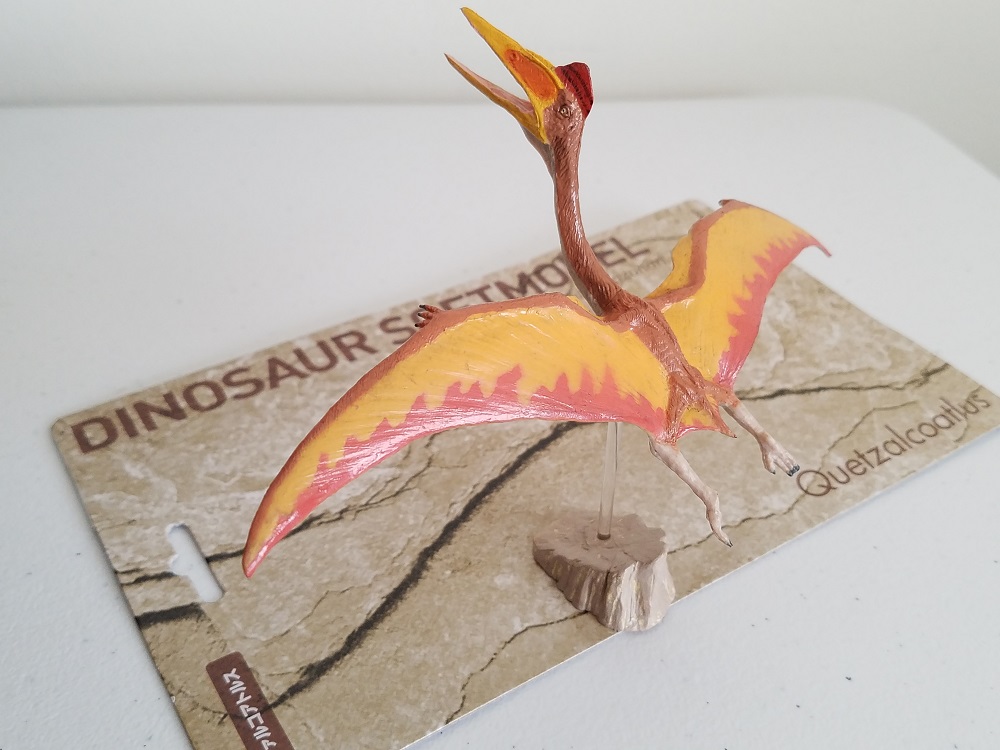
It might be considered misleading to release Quetzalcoatlus under the “dinosaur” line; experienced collectors and enthusiasts know that pterosaurs were a line of archosaur descendants related to, but ultimately separate from dinosaurs. My best guess is that Quetzalcoatlus was included in Favorite’s Dinosaur line instead of their Prehistoric Animal line due to the sculptor of choice, Kazunaki Araki. Araki has been Favorite’s leading dinosaur sculptor for several years now, so perhaps he specifically wanted to do a pterosaur? It’s hard to say; Favorite’s official product page on their website includes a short interview with Mr. Araki, but doesn’t address this particular question.
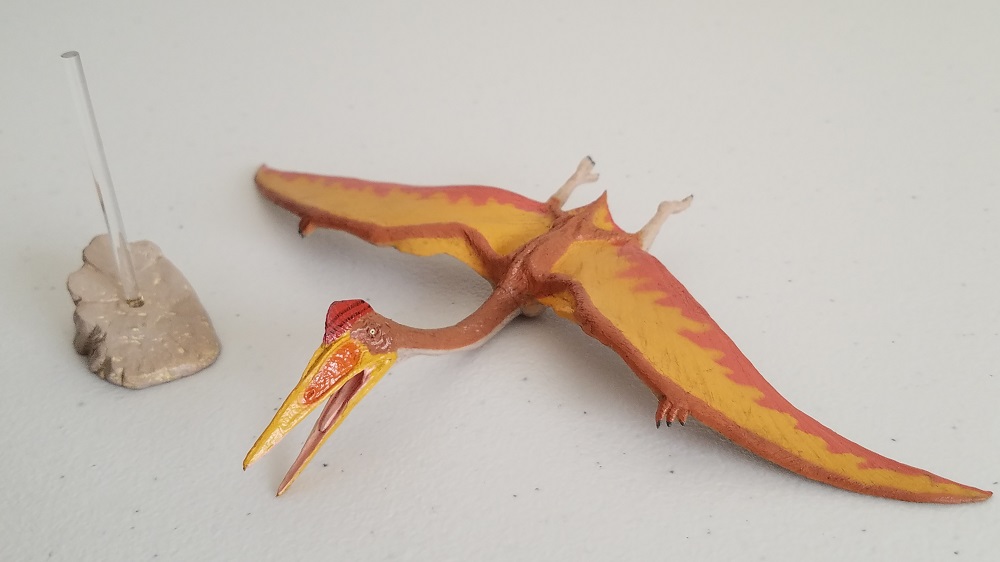
Whatever the reason, let’s have a look at the result. Favorite’s Quetzalcoatlus comes packaged in the standard cardboard and plastic slipcase provided for the soft model line. Information for the animal and the company are included on the cardboard background. A small plastic base and a clear rod are also included to help with display by inserting underneath the figure. The base has the appearance of a small, rocky outcrop like the edge of a cliff. It’s a decent-looking accessory, although it may not be strictly accurate, as large azhdarchid pterosaurs are thought to have been most at home in wide open terrain. The figure itself is posed mid-flight, wings spread and head forward. It’s a pretty standard pose for a pterosaur, but in Kazunaki Araki’s comments on Favorite’s website product page, he cites his choice of flying position as being due to Western reconstructions favoring the landing pose recently (which is somewhat true). A little extra dynamism is provided in arching the Quetz’s neck upwards and opening the mouth, suggesting a loud call (perhaps an announcement or alarm) in flight. Due to the packaging, the lower jaw can experience slight warping. A gentle curvature in the wings also helps the figure appear more organic.
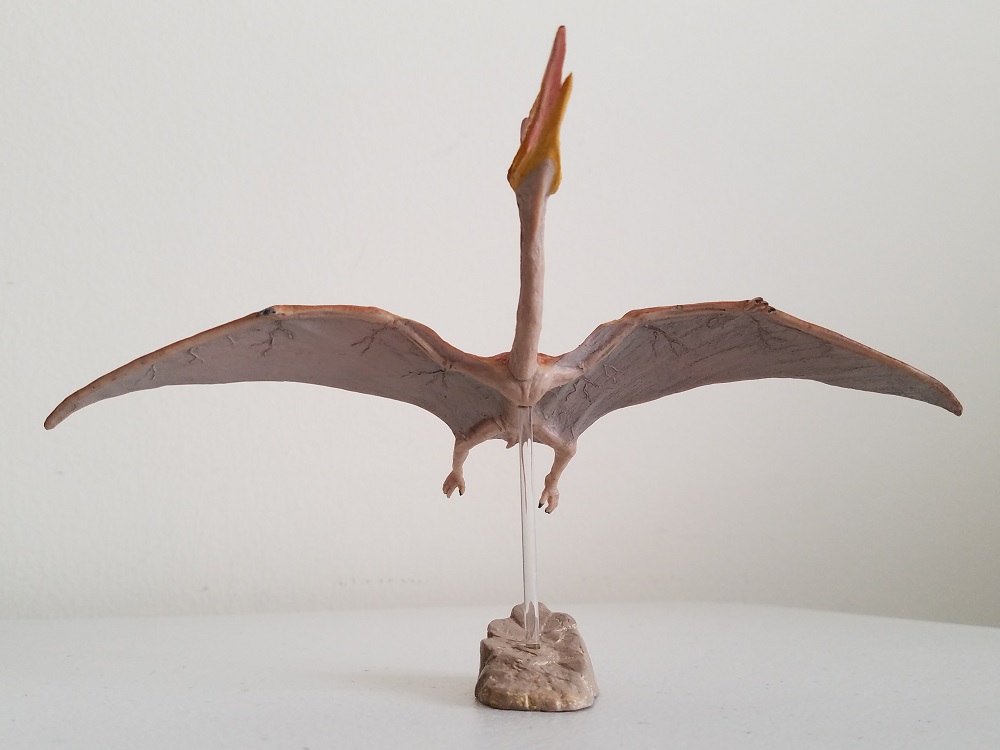
There are currently two recognized species of Quetzalcoatlus: Q. sp., known from mostly complete remains, and the larger Q. northropi, known only from a few wing bones. Popular reconstructions tend to be a hybrid of Q. sp‘s anatomy and Q. northropi‘s size, and both species are overdue for a full scientific description. As such, judging the accuracy of a reconstruction comes with a level of ambiguity. Favorite lists the size of their figure’s real life model as 10-11 meters in length (wingspan?), which matches the estimated size for Q. northropi. The figure itself measures 8 inches (about 20.5 cm) from wingtip to wingtip, so we can assume a scale of roughly 1:51. Based on current reconstructions of Quetzalcoatlus, mostly derived from Q. sp., Favorite’s figure appears reasonably up to date, with a few potential discrepancies. Quetzalcoatlus had an incredibly long skull and neck in proportion to its body size, and each is depicted here as equal length to the body. In fact, the most recent skeletal drawings by artists such as Mark Witton suggest that the skull and neck could have reached up to twice and thrice the body length respectively, so the soft model figure may prove too conservative in these proportions.
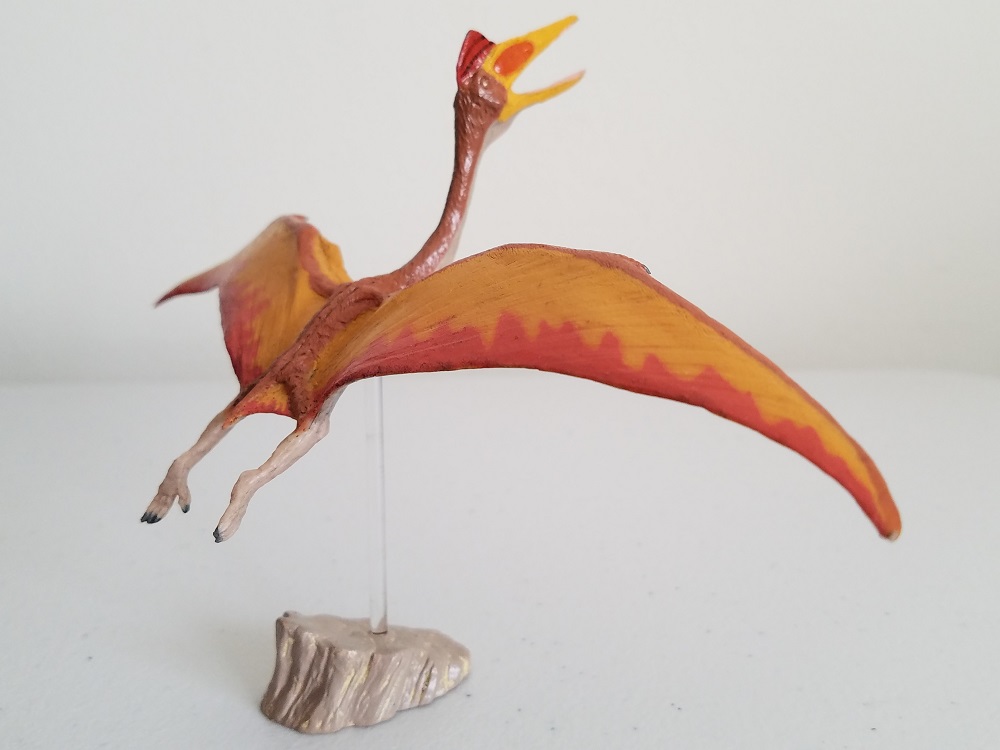
In a similar manner, the hindlimbs should be closer in length to the forelimbs; this was ultimately a quadrupedal animal built for long periods of land travel. The body itself was very compact, to an absurd-looking level in comparison to the appendages. In contrast, the figure’s wing fingers are actually longer than what is thought to be accurate for the genus. Araki’s comments imply the wing sizes were adjusted on the model, as he thought reconstructions of the animal’s wings looked too small to fly. Since only fragments of Q. northropi’s wing are officially known, Araki’s artistic license may prove true in the future; only time and further research can truly tell.

One frequent issue that arises with Kazunaki Araki’s models is his tendency to “shrink wrap” his designs – exposing more of the animal’s skeletal frame than is likely realistic. Pterosaurs were built very lightweight, but powered flight still requires efficient musculature. Araki’s Quetzalcoatlus features decently-sized pectoral muscles, but otherwise the torso appears nondescript; a more robust build would not be inappropriate here. Along the back, the spine, shoulder blades, and hips are prominently outlined in a manner that suggests an unusually gaunt animal, but the most startling details are in the undersides of the wings. There, one can make out the individual bones including the ulna, radius, and carpal bones along the length of each arm. Large, pulsing blood vessels also branch out from the limb joints across the wings, and, not surprisingly, the large antorbital fenestra are prominently outlined on the skull. This Quetzalcoatlus looks like it’s in very bad health, and I doubt it would be capable of flight anymore. Everyone’s experiences will differ, but I think this is one of the worst cases of shrink wrapping I’ve seen on a toy.
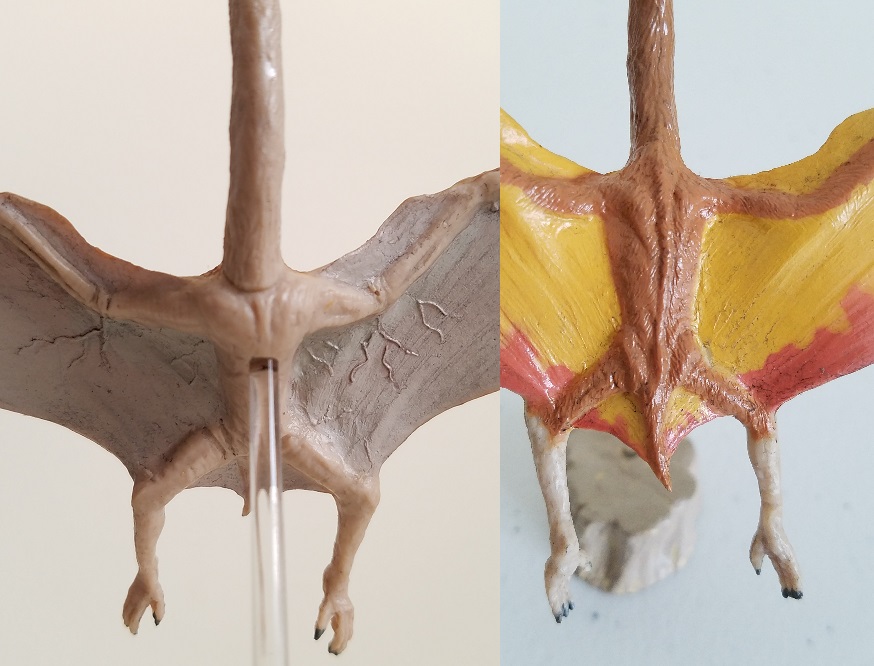
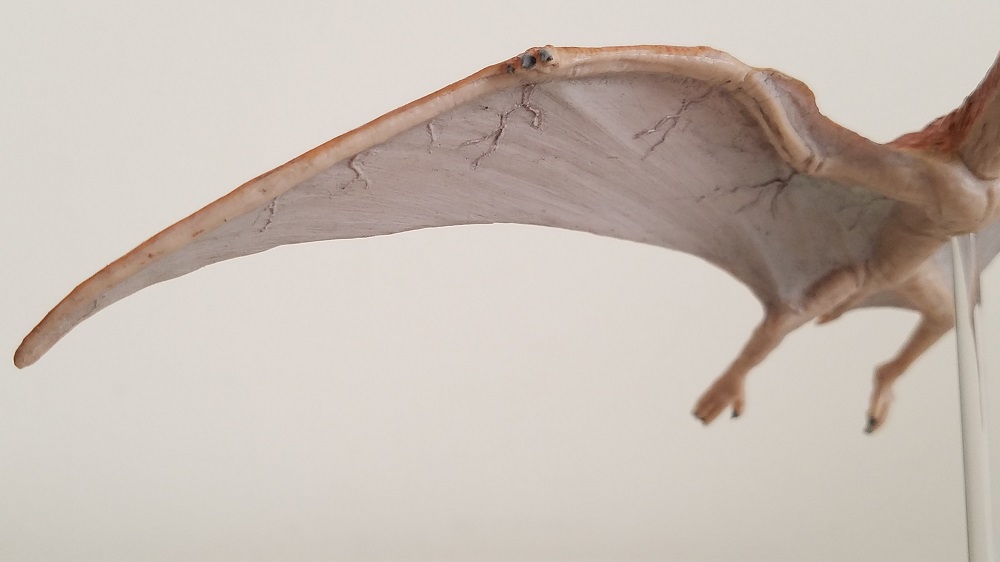
On a more positive front, there are nice details in the stretched texture of the wings, and a faint “hairy” texture is evident on the figure’s back and neck, acknowledging the possibility of a pycnofibre coating on the animal. Coloration for the figure comes in solid tones of yellow, orange, light brown, and tannish-grey. Araki notes that he referenced tropical birds for the beak coloration, but wanted to avoid flashy colors for the main body, due to the animal’s size. While this line of reasoning is fair (extant large animals do tend to be less brightly colored), I find the statement a little funny here, as the yellow and orange coloration on the beak is the same as applied to the back of the wings, resulting in a fairly bright pattern from above. Underneath, the body and wings are much more plain, although the blood vessels and bones are given a slightly darker outline, which is a bit unsettling. Application is very good on the details, with individually painted toe claws and neat, tiny yellow eyes. The crest atop the animal’s head is red with black stripes, offering a little more display, potentially to communicate with others of the same species. The dinosaur soft models tend to receive a glossy finish, but the Quetz appears a little less glossy than some previous figures (which suits me fine, as I find it distracting).

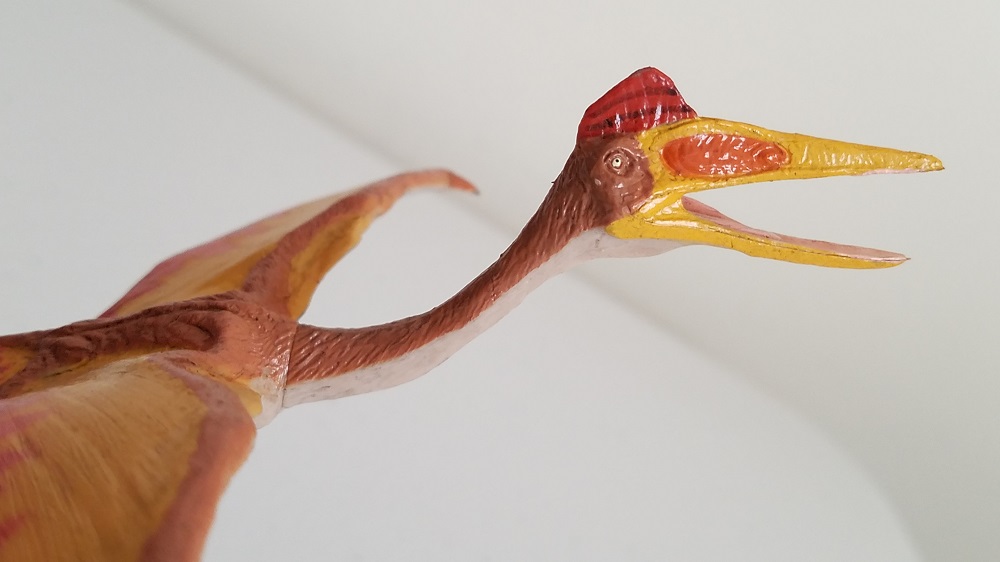
Favorite’s soft model Quetzalcoatlus looks pretty good at a glance, but there are definite issues with the design which may turn off more serious-minded collectors. On the plus side, although the figure isn’t widely available, it can be found for quite cheap on Amazon Japan, so if you’re mindful of shipping prices, this can prove to be one of the more affordable azhdarchids currently on the market.
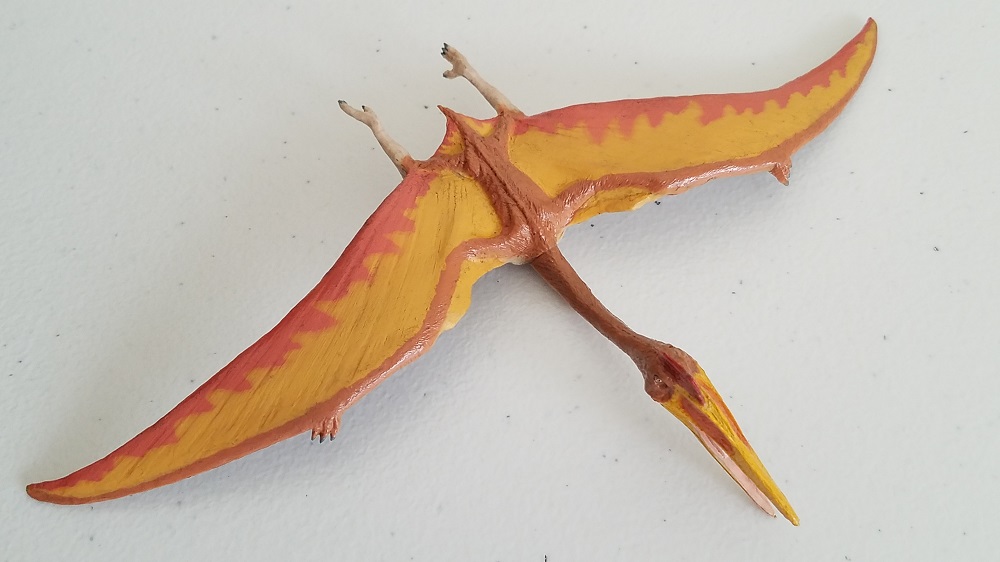
Support the Dinosaur Toy Blog by making dino-purchases through these links to Ebay and Amazon. Disclaimer: links to Ebay.com and Amazon.com on the Dinosaur Toy Blog are often affiliate links, when you make purchases through these links we may make a commission

What are those protruding toe-like things on the bottom side of the feet? They aren’t Metatarsal 5 because they are on the wrong side of the ankle.
Good review of this figure. I find it odd that for a pterosaur that has been made many time, I still don’t find many of them that good.
The only one I have that is out is the Papo one since it’s the most “non-toy” looking to me.
And no kidding about those details on the underside!
It would have been interesting if they had added some extra pycnofibers on the pterosaur’s torso, it still has some pretty interesting venous details on the wings. He’s in the mid-range of awesomeness although honestly Favorite’s pteranodon from the same factory far exceeds that figure.
Very odd how long he made the torso, but I suppose I shouldn’t be surprised given the loooong legs he gave the Carnotaurus. Great review!